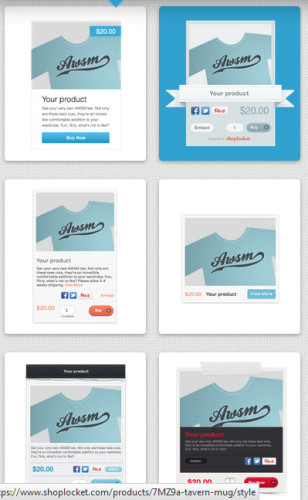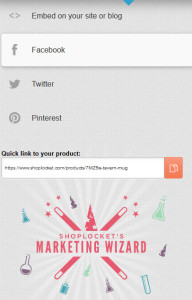![]() E-Commerce is hard, for both developers and end users. That’s why I was happy to see something like ShopLocket come across my inbox. ShopLocket is perfect for those who have one, or just a few products to sell on their website. Instead of going through the process of installing an entire e-commerce system like WooCommerce, Shopp, or WP E-Commerce, you can use ShopLocket to create a product widget, embed it on a page and start selling.
E-Commerce is hard, for both developers and end users. That’s why I was happy to see something like ShopLocket come across my inbox. ShopLocket is perfect for those who have one, or just a few products to sell on their website. Instead of going through the process of installing an entire e-commerce system like WooCommerce, Shopp, or WP E-Commerce, you can use ShopLocket to create a product widget, embed it on a page and start selling.
Getting Started:
Connecting the plugin to the ShopLocket website was an easy process. In fact, unlike most other plugins, I didn’t have to enter an API key. I only had to authorize ShopLocket access to my website via a token. Once the two are connected, two things happen. A new button is added to the post/page writing panel called Add Product and a new ShopLocket widget is added to the list of available widgets. The add product button will add a shortcode within the post that will link to the product you choose.
All of the product creation steps occur on the ShopLocket website. You start off by naming your product, giving it a price, providing a short description and then adding up to four product images. You can then select whether your product will be a digital file for download or if it will ship to customers. Then, if you would like to customize the product even more, there are the advanced options that enable you to add different variants of options such as Size, Color, etc. You can also charge a set tax, track the number of stock, shipping, expiration date, comparison price (in case it’s on sale) provide a custom landing page URL or accept pre-orders.
Once all the product information is complete, the next step is to style the widget. Because this is a hosted service out of your control, you don’t have the ability to perfectly match up the widget to an existing design. However, between the six different styles, there should be one that fits. It would be nice if we could at least change the background colors or the button colors but it’s not a deal breaker. After you’ve chosen a design of your liking, the next step is to publish the product.

After the product has been published, you’ll be provided an embed code to place the product anywhere on your site. Alternatively, you can link directly to the product page on ShopLocket.com. The marketing wizard is composed of a sidebar with links to Facebook, Twitter, and Pinterest.

After the product is published, you’re ready to start taking orders. In order to process payments, ShopLocket supports Paypal and Stripe. If you don’t have either, you’ll be given an allotment of type to set up each account. Since ShopLocket is doing most of the hard work, they get paid 2.5% on any transaction you make. This is in addition to any Paypal or Stripe fees.
One of the best aspects of ShopLocket is that buyers won’t have to add an item to a shopping cart and then go to a separate website to check-out. This keeps the buyer engaged and more likely to go through the entire check-out process.
Conclusion:
Overall, my experience of creating and sharing products with ShopLocket was great. I think something like this is a huge deal for people who have a select amount of items to sell, without needing a catalog. Sure, you could go through the process of configuring a Paypal button specifically for a product but going through ShopLocket seems so much easier. Setting up an entire e-commerce system for just a few products doesn’t make a lot of sense to me when something like this exist. Another reason ShopLocket is a big deal is because of WordPress.com. WordPress.com has a strict assortment of widgets and to the best of my knowledge, there has never been a way to do anything involving e-commerce on WordPress.com websites.
Back on March 28th of this year, it was announced WordPress VIP and Enterprise customers would be the first to get access to ShopLocket integration. At some point down the road, this service will be available to the regular WP.com customer base but it’s not clear whether it will be a paid upgrade or if it will be allowed for free across all sites. I’d be very surprised if WordPress.com didn’t charge for this as an upgrade. But considering how many talented people there is writing on WordPress.com, something like this could provide many with the ability to make some cash through physical or digital goods instead of having to rely on ads.

